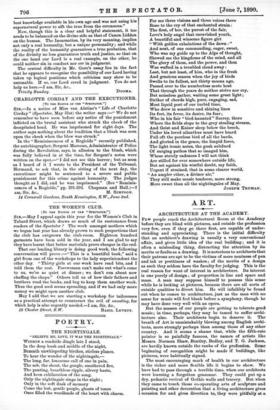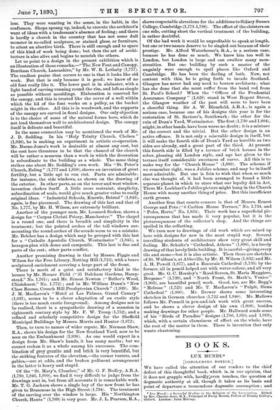ART.
ARCHITECTURE AT THE ACADEMY.
FEW people reach the Architectural Room at the Academy before they are blind with pictures, and outside the profession very few, even if they go there first, are capable of under- standing and appreciating. There is the initial difficuky that an architect's drawing is usually a very conventional affair, and gives little idea of the real building ; and it is often a misleading thing, distracting the attention by its merits or faults as a drawing. It is notorious to architects that their patrons are apt to be the victims of mere neatness of pen and ink or prettiness of washes ; of the merits of a design as such they seldom have the faculty for judging. This is the real reason for want of interest in architecture. Its interest is one purely of design ; of proportion in line and space and mass. A man may suppose himself to possess this sense while he is looking at pictures, because there are all sorts of outside qualities to divert him. He will infallibly be found out when he comes to architecture, just as the man with no sense for music will feel blank before a symphony, though he may have done very well with an opera.
But the masses of our people are getting to tolerate good music; in time, perhaps, they may be tamed to suffer archi- tecture also. Their architects begin to deserve it. The breath of Art is unmistakably blowing among English archi- tects, more strongly perhaps than among those of any other country. And it seems a shame that, while the fifth-rate painter is so painfully famous, the names of artists like Messrs. Norman Shaw, Bentley, Bodley, and T. G. Jackson, are hardly known outside the ranks of the profession. Some beginning of recognition might be made if buildings, like pictures, were habitually signed.
The most encouraging mark of health in our architecture is the richer and more flexible life it begins to show. We have had to pass through a terrible time, when our architects were learning a forgotten grammar. They could put up a dry, pedantic revival of Gothic walls and tracery. But when they came to touch those co-operating arts of sculpture and painting and other decoration that a living architecture gives occasion for and gives direction to, they were pitifully at a
loss. They were wanting in the sense, in the habit, in the .craftsmen. Shops sprang up, indeed, to execute the architect's want of ideas with a tradesman's absence of feeling; and there is hardly a church in the country that has not some dull monster in so-called sculpture, or stained glass, or furniture, to attest an abortive birth. There is still enough and to spare -of this kind of work being done; but then the art of archi- tecture is also alive and begins to nourish the others.
Let us point to a design in the present exhibition which is an illustration of these remarks,—" The New Font and Canopy, Bentham Church, Lancashire," by Mr. W. R. Lethaby (1,717). The readiest praise that occurs to one is that it looks like old work. But that is only because it is good; we know of no old font really like it. The lower part is in alabaster, with a light band of carving running round the rim, and left as simple as possible without mouldings. Elaboration is reserved for the canopy, and this is treated like the cover of a well within which the lid of the font works on a pulley, as the bucket might in the other. All this is in woodwork, and the supports of the canopy are carved in floral designs. Our only objection is to the choice of some of the natural forms here, which do not lend themselves well to architectural design. The canopy itself is delicate and beautiful.
In the same connection may be mentioned the work of Mr. J. D. Se,dding. In his "Holy Trinity Church, Chelsea" (1,936), he is making an experiment in artistic co-operation. Mr. Burne-Jones's work is desirable at almost any cost, but the cost here threatens to be that the chancel of the church will be rather a museum than a work in which the decoration is subordinate to the building as a whole. The same thing strikes one about Mr. Sedding's own work. His "St. Peter's Church, Ealing" (1,777 and 1,859), shows an invention of great fertility, but a little apt to run riot. Parts are admirable: for instance, the side windows, as shown on the drawing of the exterior. In other parts, as on the tower and west window, invention chokes itself. A little more restraint, simplicity, subordination of scale, would give much greater value to really original ideas. "Industrial Schools, Knowle, Bristol" (1,843), again, is fine piecemeal. The drawing of this last and that of No. 1,777, by Mr. H. Wilson, are extremely brilliant.
Another of the younger men, Mr. Leonard Stokes, shows a design for "Corpus Christi Priory, Manchester." The chapel is a round one, and there is breadth and simplicity in the treatment; but the pointed arches of the tall windows sur- mounting the round arches of the arcade seem to us a mistake. Mr. Belcher has a design which may be grouped with this last f or a "Catholic Apostolic Church, Westminster" (1,845), a h exagon plan with dome and campanile. This last is fine and parts of the rest; other parts conflict.
Another promising drawing is that by Messrs. Figgis and Wilson for the Free Library, Notting Hill (1,713), with a brave sculptured enrichment covering a large part of the front.
There is merit of a quiet and satisfactory kind in the houses by Mr. Horace Field ("31 Daleham Gardens, Hamp- stead," No. 1,761) ; and Mr. Ernest Newton (" Buller's Wood, Chislehurst," No. 1,772) ; and in Mr. William Dunn's "New Class Rooms, Crouch Hill Presbyterian Church" (1,939). Mr. J. M. MacLaren's "Hotel at Las Palmas, Grand Canary" (1,931), seems to be a clever adaptation of an exotic style (there is too much exotic foreground). Among designs not to be realised, there is a sympathetic drawing of a mansion in eighteenth century style by Mr. F. W. Troup (1,752), and a refined and scholarly competitive design for the Sheffield Municipal Buildings by Messrs. Morris and Hunter (1,872).
Then, to turn to names of wider repute, Mr. Norman Shaw, RA., shows his design for the New Scotland Yard, now to be seen on the Embankment (1,838). As one would expect in a design from Mr. Shaw's hands, it has many merits ; but we cannot reckon it as a whole among his successes. The com- bination of grey granite and red brick is very beautiful, but the striking features of the elevation,—the corner turrets, and gables,—are at odds, and the broken pediment arrangement in the latter is heavy and stupid.
Of the "St. Mary's, Clamber," of Mr. G. F. Bodley, A.R.A. (1,780, 1,846, 1,900), we find it very difficult to judge from the drawings sent in, but from all accounts it is remarkable work. Mr. T. G. Jackson shows a single bay of the new front he has given to Brasenose in the High Street (1,794). The treatment of the carving over the window is large. His " Northington Church, Hants" (1,769) is very poor. Mr. J. L. Pearson, R.A., shows respectable elevations for the additions to Sidney Sussex College, Cambridge (1,771-1,7c). The effect of the cloisters on one side, cutting short the vertical treatment of the building, is rather doubtful.
Of the bad work it would be unprofitable to speak at length, but one or two names deserve to be singled out because of their prestige. Mr. Alfred Waterhouse's, R.A., is a serious case, because he has done so much. We know him too well in London, but London is large and can swallow many mon- strosities. But one building by such a master of the ungainly were enough to spoil places like Oxford and Cambridge. He has been the darling of both. Now, not content with this, he is going forth to invade Scotland.
Glasgow has never had any need to borrow architects ; what has she done that she must suffer from the hand red from St. Paul's School? When the "Offices of the Prudential Assurance Company" (1,828) stand in West Regent Street, the Glasgow weather of the past will seem to have been a cheerful thing. Sir A. W. Blomfield, A.R.A., is again a serious case, because one of his designs this year is for the restoration of St. Saviour's, Southwark; the other for the rain of Dean's Yard, Westminster. The first (1,730 and 1,804), might, in other hands, have been worse no doubt; it is a mixture of the correct and the trivial. But the other design is an active offence. It is not only a miserable design in itself, but it will make the fourth side of Dean's Yard as horrible as two sides are already, and a great part of the third. At present this fourth side is filled by a terrace of brick houses in the sober, pleasing old London style, and age has given to the terrace itself considerable sweetness of curve. All this is to make way for the "Church House" (1,889). The scheme, if we remember right, was a Jubilee scheme, and may be in itself most admirable. But one is fain to wish that when so much else was thought of, it had been arranged to found a little separate planet in which to store what our loyalty did in Art. There Mr. Lockhart's Jubilee picture might hang in the Church House with many another thing of price. But this insufficient earth groans.
Another firm that courts censure is that of Messrs. Ernest George and Pete (" 6 Carlton House Terrace," No. 1,734, and "Poles, Herts," No. 1,834). Their work has a superficial pic- turesqueness that has made it very popular, but it is the picturesqueness of the collector's shop. And the things are spoiled in the collecting.
We turn now to drawings of old work which are mixed up here with designs for new in the most stupid way. Several travelling students of architecture show very great skill and feeling. Mr. Schultz's "Cathedral, Athens" (1,896), is a lovely drawing of that lovely little building. It is careful—giving every tile and stone—but it is also artistic. Then there are sketches of St. Wulfran's, at Abbeville, by Mr. H. Wilson (1,832) and Mr. A. H. Powell (1,877), and a Beauvais Cathedral (1,735) by the former, all in pencil helped out with water-colour, and all very good. Mr. G. C. Horsley's "Rood Screen, St. Maria Maggiore, Bergamo" (1,739), and "North Front, St. Mark's, Venice" (1,903), are beautiful pencil work. Good, too, are Mr. Begg's " Melrose " (1,725) and Mr. T. MacLaren's "Pulpit, Siena, Cathedral" (1,860). Mr. Brewer shows some interesting sketches in German churches (1,722 and 1,940). Mr. Mallows follows Mr. Pennell in pen-and-ink work with great success, and he shows a clever design of his own (1,808), besides making drawings for other people. Mr. Hallward sends some of his "Birds of Paradise" designs (1,786, 1,910, and 1,919), which, with a certain clumsiness of effect on the whole, have the root of the matter in them. There is invention that only wants chastening.





































 Previous page
Previous page